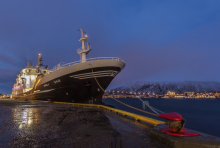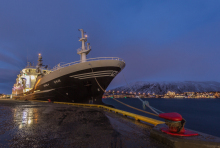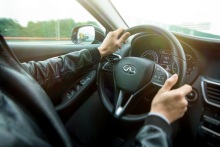【法规分类】:海事
【分类号】:Y8113199101
【时效性】:有效
【颁布日期】:1991-05-23
【实施日期】:1991-05-23
目 录
第Ⅱ—2章 构造——防火、探火和灭火
第20条修正条款 防火控制图
第21条替代条款 消防设备的即刻可用
第28条修正条款 脱险通道
第32条修正条款 通风系统
第36条修正条款 固定式探火和失火报警系统,自动喷水器、
探火和失火报警系统
第40条修正条款 消防巡逻、探火、失火报警和广播系统
第Ⅲ章 救生设备与装置
第18条替代条款 应急训练和演习
第Ⅴ章 航行安全
第17条替代条款 引航员登离船装置
第Ⅵ章 货物运输(替代文本)
A部分 通则
第1条 适用范围
第2条 货物资料
第3条 氧气分析和气体探测设备
第4条 船上使用杀虫剂
第5条 积载和紧固
B部分 谷物以外的其它散装货物的特别规定
第6条 装运的可接受性
第7条 散装货物的积载
C部分 谷物运输
第8条 定义
第9条 对谷物运输船舶的要求
第Ⅶ章 危险货物运输
第5条修正条款 证件
增加新的第7—1条 危险货物事故的报告
【名称】 1974年国际海上人命安全公约修正案〔海安会以决议MSC.22(59)于1991年5月23日通过〕
【题注】 第Ⅱ—2章 构造——防火、探火和灭火
第20条 防火控制图用下列标题取代现有标题:
“防火控制图和消防演习”在该标题后加入下列文字:
“(本条适用于所有船舶)”在本条之2后加入下列新的本条之3:“3 消防演习应按第Ⅲ/18条的规定进行。”
第21条 消防设备的即刻可用在标题后加入下列文字:
“(本条适用于所有船舶)”本条的现有文字用下文替代:
“消防设备应保持良好状况并随时可以立即使用”。
第28条 脱险通道在标题后加入下列文字:
“(本条之1.8适用于在1994年1月1日及以后建造的船舶)”在现有的本条之1.7后加入下列新的本条之1.8:“.8如果公共处所跨越三层或更多层的甲板并含有家俱等可燃物品和商店、办公室和餐厅等围闭处所,则此种公共处所内的每一层应有2条脱险通道,其中之一应能直接进入符合本条之5要求的围闭垂直脱险通道。”
第32条 通风系统在标题后加入下列文字:
“(本条之1.7适用于1994年1月1日及以后建告的船舶)”下述新的本条之1.7插入原本条之1.6和2之间:“1.7如果公共处所跨越三层或更多层露天甲板并含有家俱等可燃物品和商店、办公室和餐厅等围闭处所,则此种公共处所应配备排烟系统。该排烟系统应由要求的探烟系统起动并能手动控制。风扇的尺寸应能在10min或更短时间内将此种处所内整个容积的空气排出。”
第36条 固定式探火和失火报警系统,自动喷水器、探火和失火报警系统在标题后加入下列文字:
“(本条之2适用于在1994年1月1日及以后建造的船舶)”将原条文编为本条之1并在新的本条之1后加入下列新的本条之2:“2如果公共处所跨越三层或更多层的露天甲板并含有家俱等可燃物品和商店、办公室和餐厅等围闭处所,则含有此种公共处所的整个主垂直区域应由符合第12条的自动喷水灭火系统作全面保护。”
第40条 消防巡逻、探火、失火报警和广播系统在标题后加入下列文字:
“(本条之7适用于在1994年1月1日及以后建造的船舶)”在现有本条之6后加入下列新的本条之7:“7 如果公共处所跨越三层或更多层的露天甲板并含有家俱等可燃物品和商店、办公室和餐厅等围闭处所,则含有此种公共处所的整个主垂直区域应由符合第13条的探烟系统作全面保护,但该条之1.9除外。”第Ⅲ章救生设备与装置
第18条 弃船训练和演习本条的现有标题和文字用下文替代:
“应急训练和演习1 本条适用于所有船舶。2 手册
每间船员餐室和文娱室或每间船员住室应配备符合第51条要求的训练手册。3 集合操演和演习3.1 第个船员每月至少应参加一次弃船演习和一次消防演习。若有多于25%的船员在上一个月没有参加该特定船上的弃船和消防演习,则应在船舶驶离港口后的24h内举行该两项演习。主管机关可以接受其它安排,但这些安排至少应等同于无法实施此种做法的那些类别的船舶的安排。3.2在从事非短程国际航行的船舶上,应在旅客上船后24h内举行旅客集合操演。应向旅客讲授救生衣的用法以及在紧急情况下应采取的行动。在该次集合后如仅有为数不多的旅客在某个港口上船,则只需提请这些旅客注意第8.2条和第8.4条要求的应急须知而无需举行另一次集合操演。3.3在从事短程国际航行的船舶上,在船舶驶离后如未举行旅客集合操演,则应请旅客注意第8.2条和第8.4条要求的应急须知。3.4 每次弃船演习应包括:
.1 使用第6.4.2条要求的警报系统将旅客和船员召集到集合站并确保他们知道应变部署表中规定的弃船命令;
.2 向集合站报到并准备执行应变部署表中规定的任务;
.3 检查旅客和船员的穿着是否合适;
.4 检查是否正确地穿好救生衣;
.5 在完成任何必要的降放准备工作后,至少降下一艘救生艇;
.6 起动并操作救生艇发动机;
.7 操作降放救生筏使用的吊柱。3.5 在可行时,应按本条之3.4.5要求,在各次演习中降下不同的救生艇。3.6每条救生艇至少每3个月应在弃船演习中带着指定的操作船员被降放并在水中开动。如果从事短程国际航行的船舶因其港口靠泊装置和营运方式而不能在某舷降放救生艇,则主管机关可以允许此种船舶不在该舷降放救生艇。但是,所有此种救生艇,每3个月应至少降下一次,每年应至少降放水中一次。3.7在合理和可行时,救助艇但不包括兼作救助艇的救生艇,每月应带着指定的船员被降放并在水上进行操纵。在所有情况下,每3个月至少按此要求进行一次。3.8 如果救生艇和救助艇的降放演习系在船舶前进时进行,因其涉及危险,此种演习只应在有遮蔽的水域并且要在对此种演习有经验的驾驶员监督下进行。3.9在每次弃船演习中应检查供集合和弃船使用的应急照明。3.10 每一消防演习应包括:
.1 向集合站报到并为在第8.3条要求的应变部署表中规定的任务做准备工作;
.2 起动消防泵,至少使用两个要求的喷嘴,检查该系统是否处于正常的工作状况;
.3 检查消防员的装备和其它个人救助设备;
.4 检查有关的通信设备;
.5 检查水密门、防火门和防火挡板的运作;
.6 检查为随后的弃船所做的必要安排。3.11 在计划消防演习时应根据船型和货物充分考虑到可能发生的各种紧急情况下的习惯做法。3.12演习中使用过的设备应立即恢复到完好的工作状况;演习中发现的故障和缺陷,应尽快修复。3.13 在可行时,应按真正出现紧急情况那样进行演习。
4 船上培训和指导4.1 在新船员上船后,应在不迟于两个星期内就如何使用包括救生艇筏设备在内的船上救生设备和船上消防设备给予船上培训和指导。但是,如果船舶的船员是定期轮换的,则此种培训应在船员第一次上船后不迟于两个星期内进行。每次指导应涉及船舶救生和消防的不同方面;但在任何2个月的期限内,应涉及到该船的所有救生和消防设备。4.2每一船员均应得到指导;指导应包括但不一定局限于:
.1 船舶气胀式救生筏的操作和使用;
.2 低温受冻、低温受冻急救和其它有关的急救程序问题;
.3 在恶劣天气和恶劣海况中使用该船救生设备所必需的特别指导;
.4 消防设备的操作和使用。4.3 有关如何使用吊柱降放的救生筏的船上培训,应在不超过4个月的间隔期中在每艘装有此种设备的船上举行。凡可行时,此种培训应包括救生筏的充气和降下。此种救生筏可以是仅供培训使用的、不作为船舶救生设备组成部分的专用救生筏。此种救生筏应做有明显标志。5记录
举行集合的日期、弃船演习和消防演习的详细情况、其它的救生设备演习和船上培训,应在主管机关可能做出规定的日志上做出记录。如果在指定时间内未举行全面的集合操演、演习或培训,则应在日志中做出记录,写明所举行的集合操演、演习或培训的细节和范围。”第Ⅴ章航行安全
第17条 引航员软梯和引航员机械升降器本条的现有标题和文字用下文替代:
“引航员登离船装置(a)适用范围
(i)航行中可能使用引航员的船舶应配备引航员登离船装置。
(ii)在1994年1月1日或以后安装的供引航员登离船使用的设备和装置,应符合本条要求并充分考虑到本组织通过的标准。
(iii)在1994年1月1日前配备的供引航员登离船使用的设备和装置,至少应符合在该日期前实施的第17条的要求并充分考虑到在该日期前本组织通过的标准。
(iv)在1994年1月1日后予以替换的设备和装置,在合理和可行时,应符合本条的要求。(b)通则
(i)供引航员登离船使用的所有装置均应有效地达到使引航员安全登船和离船的目的。装置应保持干净,得到适当的维修和存放;应定期检查,保证它们的使用安全。它们仅应用于人员的登船和离船。
(ii)引航员登离船装置的安装和引航员的登船和离船,应由带有与驾驶台进行联系的通讯装置的负责的驾驶员进行监督。他还应做出安排,护送引航员经由安全通道前往和离开驾驶台。应向安装和操作任何机械设备的人员就要采用安全程序进行指导;设备在使用前应进行检查。(c)登离船装置
(i)应配备能使引航员从任一船舷安全登船和离船的装置。
(ii)在从海平面至船舶的入口或出口位置的距离超过9m的所有船上,在欲将舷梯或机械式引航员升降器或其它同样安全和方便的装置与引航员软梯一起供引航员登船或离船时,船舶应在每舷均应装有此种设备,除非该设备能移动供任一船舷使用。
(iii)应使用下列任一装置提供安全和方便的船舶入口或出口:
(1)引航员软梯。其所需爬高不超过1.5m,离水面高度不超过9m;其位置和紧固应做到:
(aa)避开船舶的任何可能的排放口;
(bb)在船舶平行船中体的长度范围内,可行时,在船舶的船中半长范围内;
(cc)每一梯阶均牢固地靠在船舷上;在护舷木等结构部件妨碍本规定的执行时,应做出使主管机关满意的特别安排,以保证人员能安全登船和离船;
(dd)引航员软梯的单根长度应能从船舶的入口或出口点抵及水中;应为所有的装载状况和船舶纵倾及为15度的不利横倾留出充分的余量;安全加固点、卸扣和系索至少应与扶手索的强度相同。
(2)每当水面至船舶入口点的距离超过9m时,与引航员软梯一起使用的舷梯,或其它同样安全和方便的装置。舷梯应安装在朝向船尾的位置上。在使用时,舷梯的下端应牢固地靠在船舶平行船中体长度范围内的舷边;在可行时,应牢固地靠在船中半长范围内的船舷■■■避开所有的排放口;或
(3)引航员机械升降器,其位置应在船舶平行船中体长度的范围内;可行时应在船舶的船中半长范围内;应避开所有的排放口。(d)船舶甲板入口
应配备装置确保在引航员软梯的上端或任何舷梯或其它设施的上端与船舶的甲板之间有安全、方便和无障碍的通道供任何人员登船和离船。该处的此种通道应由下列装置提供:
(i)在栏杆或舷墙中的门。应配有适当的扶手;
(ii)舷墙梯。应装有在其底部附近及在更高位置上牢固地固定在船舶结构上的两根扶手支柱。(e)舷门
供引航员登离船使用的舷门不应朝外开。
(f)引航员机械升降器
(i)引航员机械升降器及其辅助设备应是主管机关核准的型号。引航员升降器应设计成象活动梯一样工作,供一人在船舷升降;或象平台一样工作,供一人或多人在船舷升降。其设计和构造应保证引航员能安全地登船和离船,包括从升降器到甲板和从甲板到升降器的安全通道,此种通道应由有扶栏可靠保护的平台直接构成。
(ii)应配备有效的手动装置,降下或带回所载人员;该装置应保持待用状况,供没有电源时使用。
(iii)升降器应牢固地系着在船舶结构上。系着不应仅依靠船舶的舷梯扶手。应在船舶的每一舷为活动式升降器提供适当和牢固的系着点。
(iv)如果在升降器位置的通道上装有外护舷材,则此种外护舷材应切割至升降器可以靠在船舷上工作。
(v)引航员软梯应装在升降器的附近并可供立即使用,做到在升降器行程的任何位置上均可使用。引航员软梯应能从自身的进入船舶位置伸至海平面。
(vi)船舷处降下升降器的位置应做出标志。
(vii)应为活动式升降器配备适当的、有保护的贮藏位置。天气极冷时,为避免结冰危险,只应在即将使用前才装上活动式升降器。(g)有关设备
(i)在传送人员时,手头应备有立即可供使用的下列有关设备:
(1)如果引航员有此要求:两根扶手绳,直径不应小于28mm,牢固地紧固在船上;
(2)带有自亮灯的救生圈;
(3)撇缆。
(ii)在本条之(d)有此要求时,应配备支柱和舷墙梯。(h)照明
应配备适当照明,照亮舷外的登离船装置、甲板上人员登船和离船的位置和引航员机械升降器的控制装置。第Ⅵ章
第Ⅵ章的标题和文字用下文替代:货物运输A部分 通则
第1条 适用范围1 本章适用于因其对船舶或船上人员的特别危害而需在本规则所适用的一切船舶上及吨位小于500总吨的船舶上采取特别预防措施的货物的运输(不包括散装液体、散装气体或其它各章作出规定的那些方面的运输)。但是,对于吨位小于500总吨的船舶,如果主管机关认为,因航行的遮蔽性和条件,应用本章A部分和B部分的任何具体要求是不合理的和不必要的,则主管机关可采取能够保证这些船舶所需安全的其它有效措施。2为对本章A部分和B部分的规定作出补充,每一缔约国政府应保证提供有关货物及其积载和紧固的适当资料,并特别说明此种货物的安全运输所必需的预防措施。
第2条 货物资料1 发货人应在装货前及早向船长或其代理提供关于该货物的适当资料,以便能够实施此种货物的适当积载和安全运输所必需的预防措施。此种资料应在货物装船前以书面方式和适当的运输单据加以确认。2货物资料应包括:
.1 对于杂货和在货物成组运输器具中运输的货物:对货物、货物或货物成组运输器具的毛重和货物的任何有关特性的一般陈述;
.2 对于散装货物:关于货物积载因数的资料、平舱程序和,如为浓缩物或可以液化的其它货物,以证书形式出现的有关货物的含水量及其可运水份限度的额外资料;
.3 对于未按第Ⅶ/2条规定分类但具有造成潜在危害的化学性质的散装货物:除上述各项要求的资料外,还应有关于其化学性质的资料。3在货物成组运输器具装船前,发货人应确保此种器具的毛重与运输单据中声明的毛重是一致的。
第3条 氧气分析和气体探测设备1 在运输可能释放有害或易燃气体或可能在货物处所中造成氧气耗竭的散装货物时,应提供用以测量空气中有毒或易燃气体浓度或氧气浓度的仪表及其详细的使用说明书。此种仪表应使主管机关满意。2主管机关应采取措施,保证船员受到使用此种仪表的培训。
第4条 船上使用杀虫剂
在船上使用杀虫剂时应采取适当预防措施,尤其是为熏舱而使用杀虫剂。
第5条 积载和紧固1 在甲板上和甲板下运输的货物和货物成组运输器具,在可行时,其积载和紧固应做到能在航行全过程中防止对船舶和船上人员的损害或危险并防止货物的落水灭失。2在货物成组运输器具中装载的货物,其在器具中的装箱和紧固应做到能在整个航程中防止对船舶和船上人员的损害或危险。3 在重货或异常外形尺寸货物的装船和运输过程中,应采取适当预防措施,确保不发生船舶结构性损害,在整个航程中保持适当稳性。4在货物成组运输器具在滚装船上的装货和运输过程中,应采取适当预防措施,尤其是对此种船上和货物容器上的紧固装置以及紧固位置和系绳的强度。5 集装箱的装载不应超过《国际集装箱安全公约》(CSC)规定的安全核准牌上注明的最大总重量。B部分谷物以外的其它散装货物的特别规定
第6条 装运的可接受性1 在散装货物装船前,船长应得到有关船舶稳性和有关标准装船条件货物分布的综合资料。提供此种资料的方法,应使主管机关满意。2浓缩物或可以液化的其它货物只有在其实际含水量小于其可运水份限度时才应被接受装船。但是,如果做出了使主管机关满意的安全布置,确保在货物移动时有足够的稳性而且船舶具有适当的结构完整性,则即使其含水量超过了上述限度,仍可接受此种浓缩物和其它货物装船。3非属按第Ⅶ/2条规定作出分类的货物但具有可以造成潜在危害的化学性质的散装货物,在装船之前,应为其安全运输采取特别的预防措施。
第7条 散装货物的积载1 为了减少货物移动的风险,确保在航行全过程中保持适当的稳性,如必要,在装船和平舱时,应使散装货物在货物处所的整个范围内达到合理的水平度。2在二层舱中装散装货物时,如果装船资料指出,如此种二层舱口开着会使船底结构的应力达到不能接受的程度,则应关闭舱口。货物在平舱时应达到合理的水平度并应延伸至二层舱的整个范围,或用有足够强度的附加纵向隔板加以固定。应遵守二层舱的负荷容量,保证不使甲板结构过量负载。C部分谷物运输
第8条 定义
除另有明文规定外,在本部分中:1 “《国际谷物规则》”系指海上安全委员会以MSC.23(59)决议通过的《国际散装谷物安全运输规则》。该规定可由本组织作出修正,但此种修正案应按本公约第Ⅷ条有关适用于除第Ⅰ章外的附则的修正程序的规定被通过、生效和实施。2 “谷物”一词包括小麦、玉蜀黍(苞米)、燕麦、稞麦、大麦、大米、豆类、种子以及由其加工的与谷物在自然状态下具有相同特点的制成品。
第9条 对谷物运输船舶的要求1 运输谷物的货船,除应符合本条的任何其它适用要求外,还应符合《国际谷物规则》的要求并应持有该规则要求的许可证。就本条而言,该规则的要求应视为强制性的。2在船长未使主管机关或代表主管机关的装货港的缔约国政府确信船舶在提议的装载条件下符合《国际谷物规则》的要求之前,没有此种证件的船舶不得装谷物。”第Ⅶ章 危险货物运输
第5条 证件本条之3的现有条文用下列3、4、和5替代:3 负责在货物集装箱或车辆中装危险货物的人员,应出示经签署的集装箱装箱证书或车辆装车声明,其中写明:成组货物运输器具中的货物已得到正确的装填和紧固并符合一切适用的运输要求。此种证书或声明可与本条之2中所述的证件结合在一起。4如有充分理由怀疑装有危险货物的集装箱或车辆不符合本条之2或3的要求,或者,如果没有集装箱装箱证书或车辆装车声明,则此种货物集装箱或车辆不应被接受发运。5 运输危险货物的每一船舶应有特别的清单或舱单,按第2条规定的分类,列出船上的危险货物及其位置。按照类别标明并列出船上所有危险货物位置的详细的积载图,可用以代替此种特别清单或舱单。在船舶驶离前应向港口国当局指定的人员或组织提供其中某一证件的副本。”
在第7条后加上下列新的第7—1条:
“第7—1条 危险货物事故的报告1 在发生了包装的危险货物从船上落入海中灭失或可能灭失的事故时,船长或负责该船的其他人应立即将此种事故的详细情况尽可能最充分地向最近的沿海国报告。这种报告应根据本组织通过的指南和总原则作出。2在本条之1中所述的船舶被遗弃时,或在从此种船上发出的报告不完整或得不到时,该船的所有人、承租人、管理人或经营人或这些人的代表应在可能的最充分的范围承担本条对船长规定的义务。”
【名称】 AMENDMENTS TO THE INTERNATIONAL CONVENTION FOR THE SAFETY OF LIFEATSEA, 1974
【题注】 [Adopted on 23 May 1991 by Resolution MSC. 22(59)]Whole document
TABLE OF CONTENTS
CHAPTER II-2 CONSTRUCTION-FIRE PROTECTION, FIRE DETECTION AND FIREEXTINCT ION
Amendment to Regulation 20 Fire control plans and fire drills
Amendment to Regulation 21 Ready Availability of fire-extinguishingappliances
Amendment to Regulation 28 Means of escape
Amendment to Regulation 32 Ventilation systems
Amendment to Regulation 36 Fixed fire detection and fire alarmsystems, automatic sprinkler, fire detection and fire alarm systems
Amendment to Regulation 40 Fire patrols, detection, alarms and publicaddress systems
CHAPTER III LIFE-SAVING APPLIANCES AND ARRANGEMENTS
Replacement of Regulation 18 Emergency training and drills
CHAPTER V SAFETY OF NAVIGATION
Replacement of Regulation 17 Pilot transfer arrangements
CHAPTER VI CARRIAGE OF CARGOES (Replacement)
PART A GENERAL PROVISIONS
1 Application
2 Cargo information
3 Oxygen analysis and gas detection equipment
4 The use of pesticides in ships
5 Stowage and securing
PART B SPECIAL PROVISIONS FOR BULK CARGOES OTHER THAN GRAIN
6 Acceptability for shipment
7 Stowage of bulk cargo
PART C CARRIAGE OF GRAIN
9 Requirements for cargo ships carrying grain
CHAPTER VII CARRIAGE OF DANGEROUS GOODS
Amendment to Regulation 5 Documents
Addition of new Regulation 7-1 Reporting of incidents involvingdangerous
AMENDMENTS TO THE INTERNATIONAL CONVENTION FOR THE SAFETY OF LIFE AT SEA,1974[Adopted on 23 May 1991 by Resolution MSC. 22(59)]CHAPTER II-2 CONSTRUCTION-FIRE PROTECTION, FIRE DETECTION AND FIREEXTINCTION
Regulation 20 Fire Control Plans
The existing heading is replaced by the following: "Fire control plansand fire drills"
The following text is inserted after the heading: "(This Regulationapplies to all ships)"
The following new paragraph 3 is added after paragraph 2:
"3 Fire drills shall be conducted in accordance with the provisions ofRegulation III/18."Regulation 21 Ready Availability of Fire-extinguishing Appliances
The following text is added after the heading: "(This Regulationapplies to all ships)"
The existing text of this Regulation is replaced by the following:
"Fire-extinguishing appliances shall be kept in good order and beavailable for immediate use at all times".Regulation 28 Means of escape
The following text is inserted after the heading:
"(Paragraph 1.8 of this Regulation applies to ships constructed on orafter 1 January 1994)"
The following new subparagraph 1.8 is added after existingsubparagraph 1.7:
".8 Where public spaces span three or more decks and containcombustibles such as furniture and enclosed spaces such as shops, officesand restaurants, each level within the space shall have two means ofescape, one of which shall give direct access to an enclosed verticalmeans of escape meeting the requirements of paragraph 5".Regulation 32 Ventilation systems
The following text is inserted after the heading:
"(Paragraph 1.7 of this Regulation applies to ships constructed on orafter 1 January 1994)"
The following new paragraph 1.7 is inserted between existingparagraphs 1.6 and 2:
"1.7 Where public spaces span three or more open decks and containcombustibles such as furniture and enclosed spaces such as shops, officesand restaurants, the space shall be equipped with a smoke extractionsystem. The smoke extraction system shall be activated by the requiredsmoke detection system and be capable of manual control. The fans shall besized such that the entire volume within the space can be exhausted in 10min or less."Regulation 36 Fixed fire detection and fire alarm systems, auto-matic sprinkler, fire detection and fire alarm systems
The following text is inserted after the heading:
"(Paragraph 2 applies to ships constructed on or after 1 January1994)"
The existing paragraph is numbered as paragraph 1, and the followingnew paragraph 2 is added after new paragraph 1:
"2 Where public spaces span three or more open decks and containcombustibles such as furniture and enclosed spaces such as shops, officesand restaurants, the entire main vertical zone containing the space shallbe protected throughout with an automatic sprinkler system in compliancewith regulation 12."Regulation 40 fire patrols, detection, alarms and public addresssystems
The following text is inserted after the heading:
"(Paragraph 7 applies to ships constructed on or after 1 January1994)"
The following new paragraph 7 is added after existing paragraph 6:
"7 Where public spaces span three or more open decks and containcombustibles such as furniture and enclosed spaces such as shops, officesand restaurants, the entire main vertical zone containing the space shallbe protected throughout with a smoke detection system complying withRegulation 13, with the exception of paragraph 1.9."CHAPTER III LIFE-SAVING APPLIANCES AND ARRANGEMENTS
Regulation 18 Abandon ship training and drills
The existing heading and text of this regulation are replaced by the fol-lowing: "Emergencytraining and drills"
1 This Regulation applies to all ships.
2 Manuals
A training manual complying with the requirements of Regulation 51shall be provided in each crew messroom and recreation room or in eachcrew cabin.
3 Practice musters and drills
3.1 Each member of the crew shall participate in at least one abandonship drill and one fire drill every month. The drills of the crew shalltake place within 24 h of the ship leaving a port if more than 25% of thecrew have not participated in abandon ship and fire drills on board thatparticular ship in the previous month. The Administration may accept otherarrangements that are at least equivalent for those classes of ship forwhich this is impracticable.
3.2 On a ship engaged on an international voyage which is not a shortinternational voyage, musters of the passengers shall take place within24 h after their embarkation. Passengers shall be instructed in the use ofthe lifejackets and the action to take in an emergency. If only a smallnumber of passengers embark at a port after the muster has been held itshall be sufficient, instead of holding another muster, to draw theattention of these passengers to the emergency instructions required byRegulations 8.2 and 8.4.
3.3 On a ship engaged on a short international voyage, if a muster ofthe passengers is not held on departure, the attention of the passengersshall be drawn to the emergency instructions required by Regulations 8.2and 8.4.
3.4 Each abandon ship drill shall include:
.1 summoning of passengers and crew to muster stations with thealarm required by Regulation 6.4.2 and ensuring that they are made awareof the order to abandon ship specified in the muster list;
.2 reporting to stations and preparing for the duties described inthe muster list;
.3 checking that passengers and crew are suitably dressed;
.4 checking that lifejackets are correctly donned;
.5 lowering of at least one lifeboat after any necessarypreparation for launching;
.6 starting and operating the lifeboat engine;
.7 operation of davits used for launching liferafts.
3.5 Different lifeboats shall, as far as practicable, be lowered incompliance with the requirements of paragraph 3.4.5 at successive drills.
3.6 Each lifeboat shall be launched with its assigned operating crewaboard and manoeuvred in the water at least once every 3 months during anabandon ship drill. The Administration may allow ships operating on shortinternational voyages not to launch the lifeboats on one side if theirberthing arrangements in port and their trading patterns do not permitlaunching of lifeboats on that side. However, all such lifeboats shall belowered at least once every 3 months and launched at least annually.
3.7 As far as is reasonable and practicable, rescue boats other thanlifeboats which are also rescue boats, shall be launched each month withtheir assigned crew aboard and manoeuvred in the water. In all cases thisrequirement shall be complied with at least once every 3 months.
3.8 If lifeboat and rescue boat launching drills are carried out withthe ship mading headway, such drills shall, because of the dangersinvolved, be practised in sheltered waters only and under the supervisionof an officer experienced in such drills.
3.9 Emergency lighting for mustering and abandonment shall be testedat each abandon ship drill.
3.10 Each fire drill shall include:
.1 reporting to stations and preparing for the duties described inthe muster list required by Regulation 8.3;
.2 starting a fire pump using at least the two required jets ofwater to show that the system is in proper working order;
.3 checking fireman's outfits and other personal rescue equipment;
.4 checking the relevant communication equipment;
.5 checking the operation of watertight doors, fire doors, andfire dampers;
.6 checking the necessary arrangements for subsequent abandonmentof the ship.
3.11 Fire drills should be planned in such a way that dueconsideration is given to regular practice in the various emergencies thatmay occur depending on the type of ship and its cargo.
3.12 The equipment used during drills shall immediately be broughtback to its fully operational condition, and any faults and defectsdiscovered during the drills shall be remedied as soon as possible.
3.13 Drills shall, as far as practicable, be conducted as if therewere an actual emergency.
4 On-board training and instructions
4.1 On-board training and instructions in the use of the ship'slife-saving appliances, including survival craft equipment, and in the useof the ship's fire-extinguishing appliances shall be given as soon aspossible but not later than 2 weeks after a crew member joins the ship.However, if the crew member is on a regularly scheduled rotatingassignment to the ship, such training shall be given not later than 2weeks after the time of first joining the ship. Individual instruction maycover different parts of the ship's life-saving and fire-extinguishingappliances, but all the ship's life-saving and fire-extinguishingappliances shall be covered within any period of 2 months.
4.2 Each member of the crew shall be given instructions which shallinclude but not necessarily be limited to:
.1 operation and use of the ship's inflatable liferafts;
.2 problems of hypothermia, first-aid treatment of hypothermia andother appropriate first-aid procedures;
.3 special instructions necessary for use of the ship'slife-saving appliances in severe weather and severe sea conditions;
.4 operation and use of fire-extinguishing appliances.
4.3 On-board training in the use of davit-launched liferafts shalltake place at intervals of not more than 4 months on every ship fittedwith such appliances. Whenever practicable this shall include theinflation and lowering of a liferaft. This liferaft may be a specialliferaft intended for training purposes only, which is not part of theship's life-saving equipment. Such a special liferaft shall beconspicuously marked.
5 Records
The date when musters are held, details of abandon ship drills andfire drills, drills of other life-saving appliances and on-board trainingshall be record in such log-book as may be prescribed by theAdministration. If a full muster, drill or training session is not held atthe appointed time, an entry shall be made in the log-book stating thecircumstances and the extent of the muster, drill or training sessionheld."CHAPTER V SAFETY OF NAVIGATION
Regulation 17 Pilot ladders and mechanical pilot hoists
The existingheading and text of this Regulation are replaced by the following: "Pilottransfer arrangements
(a) Application
(i) Ships engaged on voyages in the course of which pilots arelikely to be employed shall be provided with pilot transfer arrangements.
(ii) Equipment and arrangements for pilot transfer which areinstalled on or after 1 January 1994 shall comply with the requirements ofthis Regulation and due regard shall be paid to the standards adopted bythe Organization.
(iii) Equipment and arrangements for pilot transfer which areprovided on ships before 1 January 1994 shall at least comply with therequirements Regulation 17 in force prior to that date and due regardshall be paid to the standards adopted by the Organization prior to thatdate.
(iv) Equipment and arrangements which are replaced after 1 January1994 shall, in so far as is reasonable and practicable, comply with therequirements of this Regulation.
(b) General
(i) All arrangements used for pilot transfer shall efficientlyfulfil their purpose of enabling pilots to embark and disembark safely.The appliances shall be kept clean, properly maintained and stowed andshall be regularly inspected to ensure that they are safe to use. Theyshall be used solely for the embarkation and disembarkation of personnel.
(ii) The rigging of the pilot transfer arrangements and theembarkation and disembarkation of a pilot shall be supervised by aresponsible officer having means of communication with the navigatingbridge who shall also arrange for the escort of the pilot by a safe routeto and from the navigating bridge. Personnel engaged in rigging andoperating any mechanical equipment shall be instructed in the safeprocedures to be adopted and the equipment shall be tested prior to use.
(c) Transfer arrangements
(i) Arrangements shall be provided to enable the pilot to embarkand disembark safely on either side of the ship.
(ii) In all ships where the distance from sea level to the pointof access to, or egress from, the ship exceeds 9 m, and when it isintended to embark and disembark pilots by means of the accommodationladder, or by means of mechanical pilot hoists or other equally safe andconvenient means in conjunction with a pilot ladder, the ship shall carrysuch equipment on each side, unless the equipment is capable of beingtransferred for use on either side.
(iii) Safe and convenient access to, and egress from, the shipshall be provided by either:
(1) a pilot ladder requiring a climb of not less than 1.5 mand not more than 9 m above the surface of the water so positioned andsecured that:
(aa) it is clear of any possible discharges from the ship;
(bb) it is within the parallel body length of the shipand, as far as is practicable, within the mid-ship half length of theship;
(cc) each step rests firmly against the ship's side; whereconstructional features, such as rubbing bands, would prevent theimplementation of this provision, special arrangements shall, to thesatisfaction of the Administration, be made to ensure that persons areable to embark and disembark safely;
(dd) the single length of pilot ladder is capable ofreaching the water from the point of access to, or egress from, the shipand due allowance is made for all conditions of loading and trim of theship, and for an adverse list of 15 °; the securing strongpoints,shackles and securing ropes shall be at least as strong as the side ropes;
(2) an accommodation ladder in conjunction with the pilotladder, or other equally safe and convenient means, whenever the distancefrom the surface of the water to the point of access to the ship is morethan 9 m. The accommodation ladder shall be sited leading aft. When inuse, the lower end of the accommodation ladder shall rest firmly againstthe ship's side within the parallel body length of the ship and, as far asis practicable, within the mid-ship half length and clear of alldischarges; or
(3) a mechanical pilot hoist so located that it is within theparallel body length of the ship and, as far as is practicable, within themid-ship half length of the ship and clear of all discharges.
(d) Access to the ship's deck
Means shall be provided to ensure safe, convenient and unobstructedpassage for any person embarking on, or disembarking from, the shipbetween the head of the pilot ladder, or of any accommodation ladder orother appliance, and the ship's deck. Where such passage is by means of:
(i) a gateway in the rails or bulwark, adequate handholds shall beprovided;
(ii) a bulwark ladder, two handhold stanchions rigidly secured tothe ship's structure at or near their bases and at higher points shall befitted. The bulwark ladder shall be securely attached to the ship toprevent overturning.
(e) Shipside doors
Shipside doors used for pilot transfer shall not open outwards.
(f) Mechanical pilot hoists
(i) The mechanical pilot hoist and its ancillary equipment shallbe of a type approved by the Administration. The pilot hoist shall bedesigned to operate as a moving ladder to lift and lower one person on theside of the ship, or as a platform to life and lower one or more personson the side of the ship. It shall be of such design and construction as toensure that the pilot can be embarked and disembarked in a safe manner,including a safe access from the hoist to the deck and vice versa. Suchaccess shall be gained directly by a platform securely guarded byhandrails.
(ii) Efficient hand gear shall be provided to lower or recover theperson or persons carried, and kept ready for use in the event of powerfailure.
(iii) The hoist shall be securely attached to the structure of theship. Attachment shall not be solely by means of the ship's side rails.Proper and strong attachment points shall be provided for hoists of theportable type on each side of the ship.
(iv) If belting is fitted in the way of the hoist position, suchbelting shall be cut back sufficiently to allow the hoist to operateagainst the ship's side.
(v) A pilot ladder shall be rigged adjacent to the hoist andavailable for immediate use so that access to it is available from thehoist at any point of its travel. The pilot ladder shall be capable ofreaching the sea level from its own point of access to the ship.
(vi) The position on the ship's side where the hoist will belowered shall be indicated.
(vii) An adequate protected stowage position shall be provided forthe portable hoist. In very cold weather, to avoid the danger of iceformation, the portable hoist shall not be rigged until its use isimminent.
(g) Associated equipment
(i) The following associated equipment shall be kept at hand readyfor immediate use when persons are being transferred:
(1) two man-ropes of not less than 28 mm in diameter properlysecured to the ship if required by the pilot;
(2) a lifebuoy equipped with a self-igniting light;
(3) a heaving line.
(ii) when required by paragraph (d), stanchions and bulwarkladders shall be provided.
(h) Lighting
Adequate lighting shall be provided to illuminate the transferarrangements overside, the position on deck where a person embarks ordisembarks and the controls of the mechanical pilot hoist."CHAPTER VI CARRIAGE OF CARGOES
The title and text of Chapter VI are replaced by the following: "CARRIAGEOF CARGOES".PART A GENERAL PROVISIONS
Regulation 1 Application
1 This Chapter applies to the carriage of cargoes (except liquids inbulk, gases in bulk and those aspects of carriage covered by otherChapters) which, owing to their particular hazards to ships or persons onboard, may require special precautions in all ships to which the presentRegulations apply and in cargo ships of less than 500 tons gross tonnage.However, for cargo ships of less than 500 tons gross tonnage, theAdministration, if it considers that the sheltered nature and conditionsof voyage are such as to render the application of any specificrequirements of part A or B of this Chapter unreasonable or unnecessary,may take other effective measures to ensure the required safety for theseships.
2 To supplement the provisions of parts A and B of this Chapter, eachContracting Government shall ensure that appropriate information on cargoand its stowage and securing is provided, specifying, in particular,precautions necessary for the safe carriage of such cargoes.Regulation 2 Cargo information
1 The shipper shall provide the master or his representative withappropriate information on the cargo sufficiently in advance of loading toenable the precautions which may be necessary for proper stowage and safecarriage of the cargo to be put into effect. Such information shall beconfirmed in writing and by appropriate shipping documents prior toloading the cargo on the ship.
2 The cargo information shall include:
.1 in the case of general cargo, and of cargo carried in cargounits, a general description of the cargo, the gross mass of the cargo orof the cargo units, and any relevant special properties of the cargo;
.2 in the case of a bulk cargo, information on the stowage factorof the cargo, the trimming procedures and, in the case of a concentrate orother cargo which may liquefy, additional information in the form of acertificate on the moisture content of the cargo and its transportablemoisture limit;
.3 in the case of a bulk cargo not classified in accordance withthe provisions of Regulation VII/2, but which has chemical properties thatmay create a potential hazard, in addition to the information required bythe preceding subparagraphs, information on its chemical properties.
3 Prior to loading cargo units on board ships, the shipper shallensure that the gross mass of such units is in accordance with the grossmass declared on the shipping documents.Regulation 3 Oxygen analysis and gas detection equipment
1 When transporting a bulk cargo which is liable to emit a toxic orflammable gas, or cause oxygen depletion in the cargo space, anappropriate instrument for measuring the concentration of gas or oxygen inthe air shall be provided together with detailed instructions for its use.Such an instrument shall be to the satisfaction of the Administration.
2 The Administration shall take steps to ensure that crews of shipsare trained in the use of such instruments.Regulation 4 The use of pesticides in ships
Appropriate precautions shall be taken in the use of pesticides inships, in particular for the purposes of fumigation.Regulation 5 Stowage and securing
1 Cargo and cargo units carried on or under deck shall be so loaded,stowed and secured as to prevent as far as is practicable, throughout thevoyage, damage or hazard to the ship and the persons on board, and loss ofcargo overboard.
2 Cargo carried in a cargo unit shall be so packed and secured withinthe unit as to prevent, throughout the voyage, damage or hazard to theship and the persons on board.
3 Appropriate precautions shall be taken during loading and transportof heavy cargoes or cargoes with abnormal physical dimensions to ensurethat no structural damage to the ship occurs and to maintain adequatestability throughout the voyage.
4 Appropriate precautions shall be taken during loading and transportof cargo units on board ro-ro ships, especially with regard to thesecuring arrangements on board such ships and on the cargo units and withregard to the strength of the securing points and lashings.
5 Containers shall not be loaded to more than the maximum gross weightindicated on the Safety Approval Plate under the International Conventionfor Safe Containers (CSC).PART B SPECIAL PROVISIONS FOR BULK CARGOES OTHER THAN GRAIN
Regulation 6 Acceptability for shipment
1 Prior to loading a bulk cargo, the master shall be in possession ofcomprehensive information on the ship's stability and on the distributionof cargo for the standard loading conditions. The method of providing suchinformation shall be to the satisfaction of the Administration.
2 Concentrates or other cargoes which may liquefy shall only beaccepted for loading when the actual moisture content of the cargo is lessthan its transportable moisture limit. However, such concentrates andother cargoes may be accepted for loading even when their moisture contentexceeds the above limit, provided that safety arrangements to thesatisfaction of the Administration are made to ensure adequate stabilityin the case of cargo shifting and further provided that the ship hasadequate structural integrity.
3 Prior to loading a bulk cargo which is not a cargo classified inaccordance with the provisions of Regulation VII/2 but which has chemicalproperties that may create a potential hazard, special precautions forits safe carriage shall be taken.Regulation 7 Stowage of bulk cargo
1 Bulk cargoes shall be loaded and trimmed reasonably level, asnecessary, to the boundaries of the cargo space so as to minimize the riskof shifting and to ensure that adequate stability will be maintainedthroughout the voyage.
2 When bulk cargoes are carried in 'tween-decks, the hatchways of such'tween-decks shall be closed in those cases where the loading informationindicates an unacceptable level of stress of the bottom structure if thehatchways are left open. The cargo shall be trimmed reasonably level andshall either extend from side to side or be secured by additionallongitudinal divisions of sufficient strength. The safe load-carryingcapacity of the 'tween-decks shall be observed to ensure that thedeck-structure is not overloaded. PART C CARRIAGE OF GRAINRegulation 8 Definitions
For the purposes of this part, unless expressly provided otherwise:
1 "International Grain Code" means the International Code for the SafeCarriage of Grain in Bulk adopted by the Maritime Safety Committee of theOrganization by resolution MSC. 23 (59) as may be amended by theOrganization, provided that such amendments are adopted, brought intoforce and take effect in accordance with the provisions of Article VIII ofthe present Convention concerning the amendment procedures applicable tothe Annex other than Chapter I.
2 The term "grain" includes wheat, maize (corn), oats, rye, barley,rice, pulses, seeds and processed forms thereof whose behaviour is similarto that of grain in its natural state.Regulation 9 Requirements for cargo ships carrying grain
1 In addition to any other applicable requirements of the presentRegulations, a cargo ship carrying grain shall comply with therequirements of the International Grain Code, and hold a document ofauthorization as required by that Code. For the purpose of thisRegulation, the requirements of the Code shall be treated as mandatory.
2 A ship without such a document shall not load grain until the mastersatisfies the Administration, or the Contracting Government of the portof loading on behalf of the Administration, that the ship will complywith the requirements of the International Grain Code in its proposedloaded condition."CHAPTER VII CARRIAGE OF DANGEROUS GOODS
Regulation 5 Documents
The existing text of paragraph 3 of this Regulation is replaced by thefollowing paragraphs 3, 4, and 5:
"3 The persons responsible for the packing of dangerous goods in afreight container or road vehicle shall provide a signed container packingcertificate or vehicle packing declaration stating that the cargo in theunit has been properly packed and secured and that all applicabletransport requirements have been met. Such a certificate or declarationmay be combined with the document referred to in paragraph 2.
4 Where there is due cause to suspect that a freight container or roadvehicle in which dangerous goods are packed is not in compliance with therequirements of paragraph 2 or 3, or where a container packing certificateor vehicle packing declaration is not available, the freight container orvehicle shall not be accepted for shipment.
5 Each ship carrying dangerous goods shall have a special list ormanifest setting forth, in accordance with the classification set out inRegulation 2, the dangerous goods on board and the location thereof. Adetailed stowage plan, which identifies by class and sets out the locationof all dangerous goods on board, may be used in place of such a speciallist or manifest. A copy of one of these documents shall be made availablebefore departure to the person or organization designated by the portState authority."
The following new Regulation 7-1 is inserted after Regulation 7:"Regulation 7-1 Reporting of incidents involving dangerous goods
1 When an incident takes place involving the loss or likely lossoverboard of packaged dangerous goods into the sea, the master, or otherperson having charge of the ship, shall report the particulars of such anincident without delay and to the fullest extent possible to the nearestcoastal State. The report shall be based on the guidelines and generalprinciples adopted by the Organization.
2 In the event of the ship referred to in paragraph 1 being abandoned,or in the event of a report from such a ship being incomplete orunobtainable, the owner, charterer, manager or operator of the ship, ortheir agents shall, to the fullest extent possible, assume the obligationsplaced upon the master by this Regulation."
(编辑:海事海商网)













































